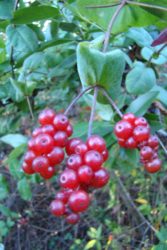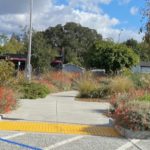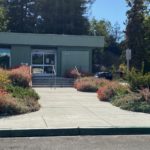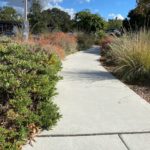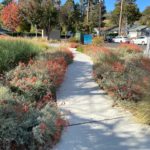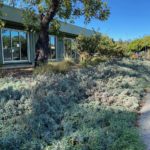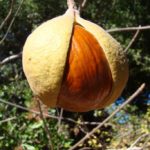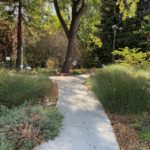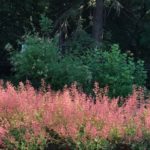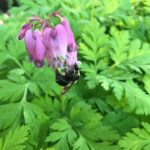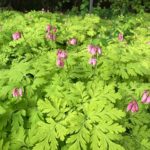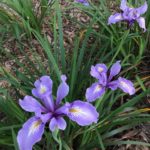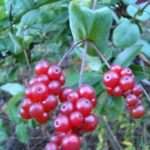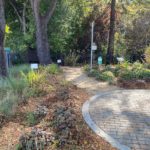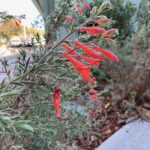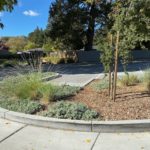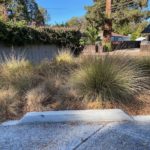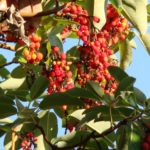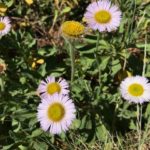Lot size: ½ acre native plant gardens and restoration project, 100% native
Garden Age: The project was installed in stages, beginning in 2002
Years on the Bringing Back the Natives Garden Tour:
Showcase Feature
Would you like to have an attractive, low-maintenance native plant garden at your own home, but need garden design ideas and plant suggestions? Or, do you wish your own library, or other local government building was landscaped with California native plants? If so, stop by the El Sobrante Library!
The demonstration garden at the rear of the garden is an oasis for wildlife, and was planned with an eye for aesthetics, as well as habitat. Meandering paths wend sunny openings into shady corners, providing the opportunity to discover plants that thrive in various conditions.
Mature live oaks and buckeyes overhang this inviting garden, with its varying colors and textures, which is also surrounded by coastal redwoods and huge black walnuts, likely descendants of those used by native peoples.
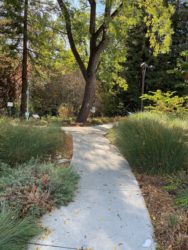 The entire area behind the library was once an ecological desert of English ivy and Himalayan blackberry. Today, thanks to the efforts of community volunteers and the restoration group SPAWNERS (San Pablo Watershed Neighbors Education and Restoration Society), this streamside site is now an inviting parklet with a plethora of local native plants that attract wildlife and people alike. Volunteers from SPAWNERS maintain the demonstration garden with hand weeding, limited pruning as needed, and no supplemental water once plants are established. Volunteers will be on hand during the tour to provide the history of the garden and practical tips for growing natives.
The entire area behind the library was once an ecological desert of English ivy and Himalayan blackberry. Today, thanks to the efforts of community volunteers and the restoration group SPAWNERS (San Pablo Watershed Neighbors Education and Restoration Society), this streamside site is now an inviting parklet with a plethora of local native plants that attract wildlife and people alike. Volunteers from SPAWNERS maintain the demonstration garden with hand weeding, limited pruning as needed, and no supplemental water once plants are established. Volunteers will be on hand during the tour to provide the history of the garden and practical tips for growing natives.
The Library’s entrance features an extensive native plant garden that contains mostly sun-loving plants. This beautiful, low-maintenance, and water-conserving garden—which, in addition to its other great features also provides habitat for wildlife—is a model for public spaces. Completed in 2017, the library landscape contains a simple but delightful combination of mostly native plants that is attractive year-round: massed low-growing, fragrant sages line the gently winding path; drifts of fuchsia brighten the garden in summer and fall; rushes stay green all year; and deergrass provides visual interest with its tall, delicate, fountain-like blades.
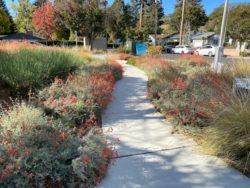 The entrance garden was created by a partnership between Supervisor John Gioia’s office, the Contra Costa County Public Works Department, the El Sobrante Library, the San Pablo Watershed Neighbors Education & Restoration Society (SPAWNERS), and local community members. (Congratulations, all, on a job well-done!)
The entrance garden was created by a partnership between Supervisor John Gioia’s office, the Contra Costa County Public Works Department, the El Sobrante Library, the San Pablo Watershed Neighbors Education & Restoration Society (SPAWNERS), and local community members. (Congratulations, all, on a job well-done!)
Bring a picnic lunch, take a seat in the amphitheater at the back of the library, and enjoy this peaceful setting.
Other Garden Attractions
• The terrific new wooden plant signs in the demonstration garden behind the library contain information on what pollinators each plant supports. Thanks to Eagle Scout Group #24 for creating them.
• Check out the mature riparian (streamside) forest, which features buckeyes, black walnuts, oaks, and sycamores with native understory species.
• A children’s garden is right across the parking area, with space to run around and a simple climbing structure for tots.
• Restrooms are available in the library!
Gardening for Wildlife
Pipevine swallowtail butterflies lay their eggs in the extensive patch of Dutchman’s pipevine. Dark-eyed juncos nest in dense plantings near the ground, while red-shouldered hawks noisily mate and raise their young overhead. Bird boxes installed by another Boy Scout project host chattering chestnut-backed chickadees and titmice. Bumblebees feast on the fairy-like soaproot flowers in the late afternoons. Deer, woodpeckers, ducks, flickers, and many other kinds of songbirds, butterflies and bees frequent the gardens and restoration site.
Garden Tours and Activities
10:30 and 12:30: Guided tours of the demonstration gardens.
10:00 – 12:00 Art project for children (of all ages). Leaf rubbings are a fun and easy way to create art with native plants, and they can be a great tool to enhance your plant identification skills as well.


